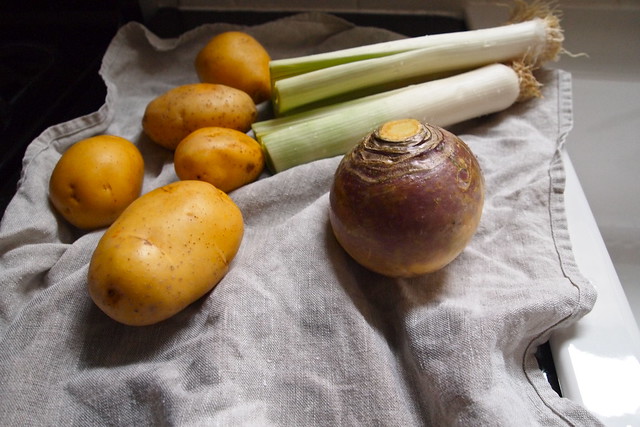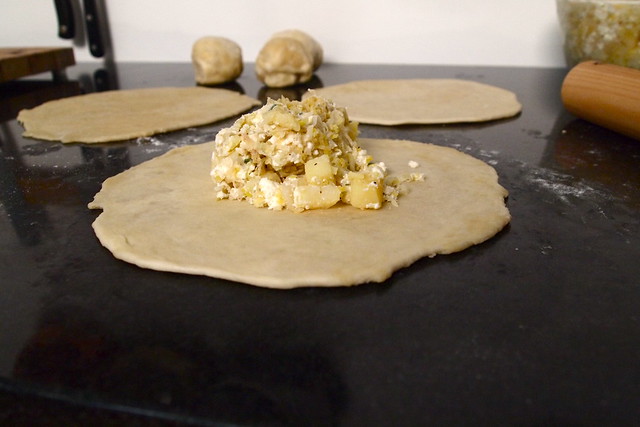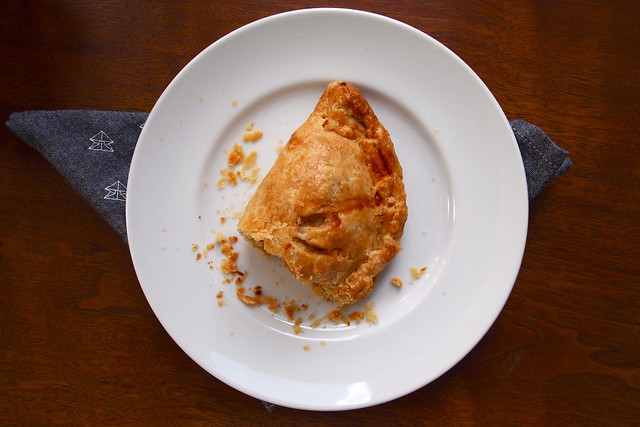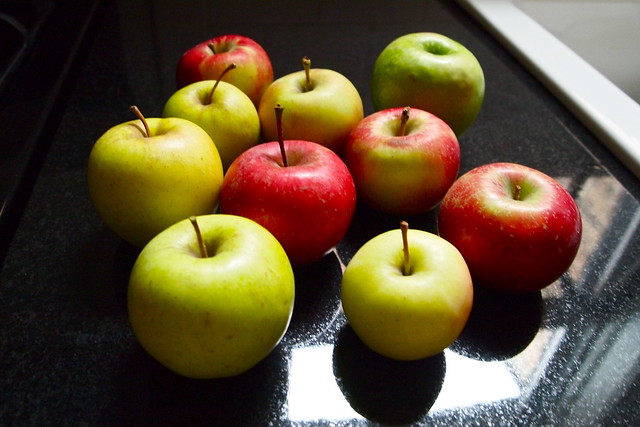When I found out that I'd be going apple-picking with some friends of mine on the weekend, my first thought was not of pies and jellies but this, "What am I going to make for us all to bring along and eat?"
I don't know what exactly this was about, but I was almost as excited about the prospect of feeding my friends on our day-trip as I was about the apples to come. Maybe it's just that I'd been wanting to go on an orchard outing like this more or less since I'd move to the city. I'd been picturing it for long enough--a long ride down quiet country roads, creaky wooden ladders, bushel barrels brimming with crisp, dappled beauties, and something homemade packed for eating out in the sunshine. Who knows. I just thought we'd need something to keep our bellies full, to keep us humming out there as we filled up our baskets, and I was tickled by the idea of having something homemade tucked away in my bag for everyone.
It had to be something that we could eat without much fuss--no forks, no juices running down our chins and arms, just a few crumbs to brush from our faces, maybe. I toyed with the idea of making homemade granola bars for a bit but decided against it. Too sugary--what we needed was sustenance. And that's when I remembered something I'd been waiting for just the right occasion to come along to make--Nigel Slater's rutabaga and cheese pasties.*
The pasty, as Slater notes, is something that, in one form or another, has been with the English for some time. (It makes an appearance in English literature as early as Chaucer's Canterbury Tales.) But for the most part, it's something associated with Cornish miners--a filling, no nonsense lunch of skirt steak, rutabaga, and potatoes (traditionally, anyway) bundled in pastry sturdy enough to hold its own in your pocket on a trip down the mine shaft. (And wrapped in newspaper, I'm told, a pasty will hold some of its warmth for a few hours.) Theirs, I thought, would be a good example to follow for our day at the orchard.
I don't know what the Cornish would have to say about Slater's pasties--they certainly aren't traditional--but my friends and I (an Englishman among us) were rather pleased. The filling, as Slater says, is gentle. The sweetness of the leeks and rutabaga mingle nicely with the goat cheese. The potatoes add a pleasing, velvety heft. And the pastry, though sturdier than most thanks to the bread flour, is surprisingly tender. Holding one by its thick, crimped edge (as the miners would), you can't help but feel that it's the sort of thing that will warm you to your toes by the time you're through with it.
The only disappointment that day was that we didn't actually go apple-picking. Because of the weather we had back in March, most orchards in the area didn't have much in the way of apples and weren't open for picking. So we ended up eating warm pasties in my living room and then heading to the farmers' market. It wasn't nearly as idyllic, but we did find a few apples.
*N.b. as my English friends have confirmed, the `a' in `pasty' is short like in `fast', not long like in `paste'.
*N.b. as my English friends have confirmed, the `a' in `pasty' is short like in `fast', not long like in `paste'.
Rutabaga and Cheese Pasties
Adapted from Nigel Slater's Tender
Note: About the fat. Traditionally, the pastry for pasties is made with lard. Slater's original recipe calls for half lard and half butter, but I wanted to keep this vegetarian. You could, of course, if so inclined, go for the lard. About the crimping. From what I understand, tradition calls for crimping and turning the dough onto itself, which creates a sort of braid-like effect (there are plenty of videos around that demonstrate the technique). It's a bit tricky and not a technique I've quite mastered (as you can see). I found that brushing the edges of the dough with egg made it more difficult to work with and was in the end unnecessary for keeping the pasties sealed. If you decide to crimp with a fork, however, I'm sure that you'll have an easier time and that the beaten egg will help. Leftover filling. I doubled the recipe and wound up with a cup or so of remaining filling. You could try scaling the recipe back a bit to correct this, but I think the filling is wonderful on its own cold, sort of like a creamy potato salad. Make ahead. You can prepare the pastry and filling a couple of days in advance, if you like, and assemble the pasties right before baking. I suspect that assembled pasties would keep well frozen (for maybe a month or so) and could be baked straight from the freezer.
PASTRY
225 g / 1 scant cup butter
450 g / 3 1/2 cups bread flour
Salt
Salt
an egg, beaten with a little milk, for brushing
FILLING
2-3 tablespoons butter
2 large leeks
1 small rutabaga (about 200 g)
2-3 medium potatoes (about 400 g)
1 bushy sprig of thyme, leaves picked and chopped
250 g goat cheese
Pepper to taste
Pepper to taste
Freeze the butter for a good hour, making it easier to grate.
Grate the frozen butter into the flour using the large holes on a box grater. This is most easily done if you keep the butter in its paper, dipping the cut edge into the flour every now and again to stop it sticking on the grater. Add a good half teaspoon of sea salt. Stir the butter into the flour along with enough cold water to make a firm but tender dough--about 13-15 tablespoons. Turn the dough out on the counter and pat it into a rough disc. Wrap it well in plastic wrap and leave it to rest in the fridge for at least 20 minutes (or up to a day or two).
Meanwhile, trim the leeks of their tough, green tops and slit them lengthwise, not quite all the way through. Rinse them thoroughly under the tap, fanning out their layers to flush away any trapped dirt. Trim them of their root end, finish the lengthwise cut, then cut them into thin slices. Let them soften in the butter in a medium saucepan over medium-low heat. Placing a layer of wax paper over the top, then covering with a lid will encourage them to steam a little and stop them colouring too quickly. Stir occasionally to prevent sticking and burning.
Peel the rutabaga and the potatoes, cut them to a half-inch dice, and boil in salted water for ten minutes. They should be just tender and cooked through. Drain.
When the leeks are soft, 8-10 minutes, mix them with the rutabaga and potatoes and season generously with black pepper and the chopped thyme. Crumble in the goat cheese. Preheat the oven to 400 degrees F.
Divide the pastry into six equal pieces. Roll each piece into a disk about 7 1/2 inches in diameter. Brush the edges with beaten egg and milk, then pile each disk with some filling, about a 1/2 cup. Fold the dough over to make a semi-circle, sealing and crimping the edges tightly. Transfer to a baking sheet lined with parchment paper. Brush the pasties with beaten egg and milk, then pierce the crust of each pasty a couple of times to make steam holes. Bake for fifteen minutes, then decrease the heat to 350 degrees F and bake for forty-five minutes or so, until golden.
Serves 6.







I've had dreams about going to the countryside and going apple picking, too. I don't know why I haven't done that since I grew up in the apple state of the country, but oh well. There's time ahead of me I guess. Shame you actually didn't get to go though! I still think it sounds fun to eat these and then trek to the farmer's market, haha. Things like this, pasties or empanadas, are always so good. The flavors in this one sound really great, and very autumnal.
ReplyDeleteapples might even make a nice addition to these pasties! Too bad that you didn't get to go, but your cozy day at home and trip to the farmers market sound lovely as well. I have to admit that I've never cooked with a rutabaga before, perhaps I'll pick one up at the famers market on Friday and experiment.
ReplyDeleteDo you think these could be frozen before baking?
ReplyDeleteHa! Nevermind-- just saw this very thing written out in your post : )
ReplyDeleteJust to add to that, Nuala, I saved three pasties from that batch I made and baked them about a week or so after that straight from the freezer. I thought they baked up quite nicely--they might not have been quite as flakey as they were fresh, but they were still very good and rather convenient.
Delete